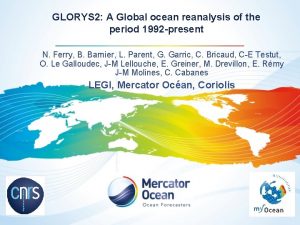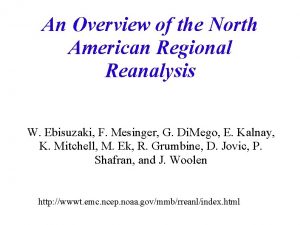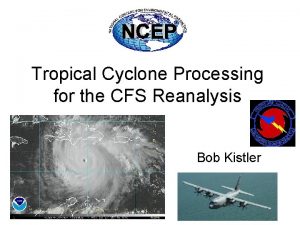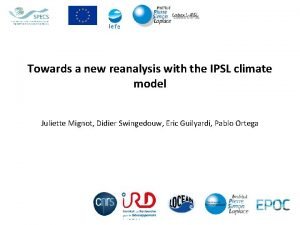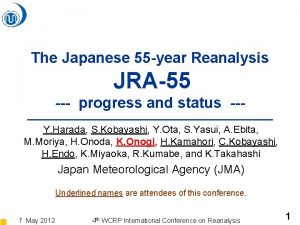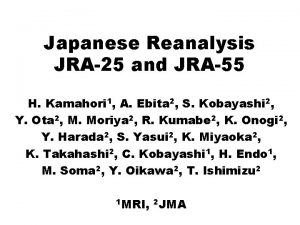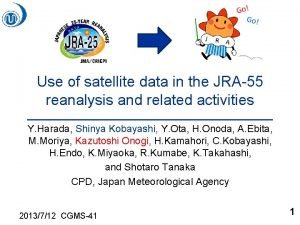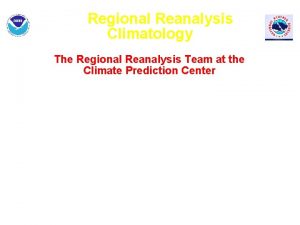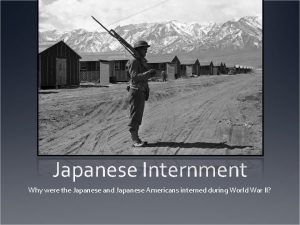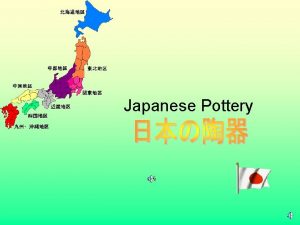JRA55 the Japanese 55 year reanalysis project status










- Slides: 10

JRA-55 the Japanese 55 -year reanalysis project - status and plan Climate Prediction Division Japan Meteorological Agency 1

JMA’s current Climate Data Assimilation System • JRA-25 (1979~2004) production finished in 2006 – jointly conducted by JMA and Central Research Institute of Electric Power Industry (CRIEPI) – freely available for research purposes • http: //jra. kishou. go. jp/JRA-25/index_en. html – A full copy of the JRA-25 data set provided to NCAR • http: //dss. ucar. edu/datasets/ds 625. 0/ • continued as JCDAS (2005~) – available 2 days behind the real time • Over 1, 300 registered users and 100 cited references as of Sep 2009 – The JRA-25 paper (Onogi et al. , 2007, JMSJ) • http: //www. jstage. jst. go. jp/article/jmsj/85/3/85_369/_article • extensively used for many activities at JMA – real-time climate monitoring, verification of seasonal forecasts, atmospheric forcing fields for the ocean data assimilation, chemical transport simulations and so on 2

Overview of JRA-55 60 -km resolution global climate data set Phase 1 (2009~2012) JRA-55 (1958~2012) Reanalysis of past observations using a constant state-of-the-art data assimilation system Boundary fields Phase 2 (2013~2015) Regional downscaling over Japan (1958~2012) Details to be determined providing a fundamental data set for Ø researches on climate change and decadal variability in the last half century Ø real-time climate monitoring Ø verification of seasonal forecast and climate models Ø atmospheric forcing fields for ocean data assimilations Ø chemical transport simulations Ø carbon cycle simulations Ø water resource management Ø estimation of renewable energy resources Ø severe weather risk assessment High-resolution (~5 km) climate data set over Japan and much more 3

Observations for JRA-55 First time for reanalyses Improved from or added to JRA-25 4

Specifications of data assimilation system Resolution Time integration JRA-25 (1979~2004) JRA-55 (1958~2012) T 106 L 40 (~120 km) TL 319 L 60 (~60 km) (top layer at 0. 4 h. Pa) (top layer at 0. 1 h. Pa) Eularian Semi-Lagrangian Line absorption Long-wave radiation Statistical band model Water vapor continuum e-type Line absorption Table lookup + K-distribution Water vapor continuum e-type + p-type 4 D-Var Assimilation scheme 3 D-Var B matrix Constant Different B matrices for pre-satellite and satellite eras Bias correction (radiosonde) Radiation bias only RAOBCORE v 1. 4 (Andrae et al. , 2004) (Haimberger, 2007, J. Climate) Offline Variational Bias Correction Bias correction (radiances) For satellite (with T 106 inner model) 5

Other changes from the JRA-25 system • Revised short-wave radiation scheme – Retuned absorption coefficients for O 3, CO 2 and O 2 – Added more bands for CO 2 and O 2 • Enhanced QC for conventional data – Application of thorough QC procedures for conventional data – Revised QC thresholds for conventional data • Improved treatment of cloud effects in the radiation scheme – Revised treatment of vertically overlapping clouds – Retuned cloud radiative properties • Introduction of a convective triggering scheme into the deep convective parameterization • Updated radiative transfer model for satellite radiances – Introduction of RTTOV-9 (Saunders et al. , 2008) 6

Boundary and forcing fields JRA-25 (1979~2004) JRA-55 (1958~2012) Radiatively active gases H 2 O, CO 2, O 3, CH 4, N 2 O, CFC-11, CFC-12, HCFC-22 GHG concentrations Constant at 375 ppmv (CO 2) vary over time Ozone Aerosols SST Sea ice Daily 3 -D ozone (produced by AED/JMA) (-1978) Monthly climatology (1979 -) New daily 3 -D ozone (produced using a revised CTM) Annual climatology for continental and maritime aerosols Monthly climatology for continental and maritime aerosols COBE SST (Ishii et al. , 2005, I. J. Clim. ) (Same as JRA-25) 7

JRA-55 production schedule • • Jul 2010 Sep 2010 Early 2013 Mid 2013 start of Stream B start of Stream A completion of production product release – Production will be continued as a new JCDAS 8

Summary • JRA-55 improves upon JRA-25 in many respects, – – a longer reanalysis period, extending back in 1958, much better forecast performance than JRA-25, significantly reduced cold bias in the lower stratosphere, and reduced dry bias over the Amazon basin. • Quality of analysis changes inevitably due to changes in observing systems, but there is a good prospect that a reasonably homogeneous analysis will be produced in the northern hemisphere troposphere. – Quality of analysis is reasonablely high over the regions that radiosondes cover even if no satellite data is available. – On the other hand, it is anticipated that analyses of the pre-satellite era would degrade seriously in the southern hemisphere troposphere. 9

Summary (cont. ) • There is a considerable possibility that quality of analysis in the presatellite era will improve by tuning the background error. – An experiment with a global constant scaling factor showed a small but positive result in the southern hemisphere. • The JRA-55 production is planned to start in Jun 2010 and expected to complete by early 2013. 10
